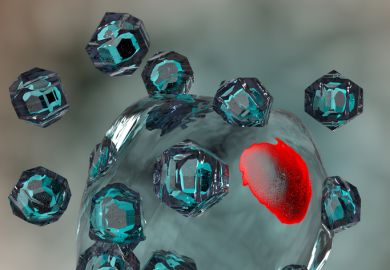Patrick Leevers is reader in polymer engineering, Imperial College, London. James Maxwell's 37 years at ICI put him at the heart of the United Kingdom plastics industry during a confident era. He has gone on to build an encyclopedic platform of knowledge from which to evangelise for the industry.
This concise eulogy for plastics, although it sometimes seems to be fighting battles long since won, is eminently timely (at least, outside what he terms the "Christmas cracker" sector). A recent conflict between Greenpeace and the PVC industry concerning dioxin evolution during incineration, and anxieties about plasticisers leached from toys sucked by children, both reached the public arena. Each debate was obscured by the smog of mistrust that lingers around polymers, the synthetic solids on which plastics are based.
Plastics is superbly organised and presented. A text well ventilated by sub-headings and black-and-white photos invites browsing as well as serious reading, although chapter titles on page headings would have helped.
Maxwell's prose style is that of the scientific journalist. His pace is breathless, occasionally risking sharp corners at excessive speed. Typos are sparse, though "Bakerlite" for Bakelite survives prominently on the back cover and "Laymann's" on the spine.
Of the nine chapters, it is those that introduce and conclude the book that most clearly reveal its message. "The status of plastics" kicks off with a lightning tour illustrating how these materials pervade every sector of technologically advanced societies. It is the final chapter,"Future conditional", where Maxwell scores most highly. Issues of environmental pollution, recyling and resource management are dealt with concisely but with exceptional breadth and clarity.
The seven intervening chapters can be seen as providing the technological context for this concluding survey. They deal, in turn, with the new applications plastics have made possible; with the pros and cons of replacing other materials by plastics in existing applications; with the way in which properties of polymers in each "family" originate from their structure; with shaping methods for plastics; with polymer-based composites and, finally, with the two principal issues of design in plastics: selecting the right material, and designing to make the best of its properties.
Unfortunately, these technological chapters seem less sure of their readership. The "layman" addressed by the book is ostensibly "anyone interested in plastics", but anyone unfamiliar with a "notched Izod impact test" or a "craze" will stumble. Compressing such a complicated field into fewer than 150 pages is an achievement that must occasionally lead to unintelligibility.
The price has been highest in the chapter on processing technology. Multi-shot injection moulding is not a forbiddingly complicated method, but an explanation in less than three lines is doomed to baffle most readers. Similarly, the reader new to "pultrusion" will find it referred to on page 89 as a compounding technique and on page 90 as a method for producing pipe, but will remain confused about what it actually is. Line diagrams have apparently been avoided as a policy - a questionable one. Where, in figure 5.6, a manufacturing process is illustrated by a series of photos, the sequence has been reversed.
Maxwell rushes on without pausing to recover the wounded. Although the verve and enthusiasm of his message is often stimulating, non-native speakers may flounder in the dense thickets of nouns that flourish so readily in technical English.
This is a valuable book for the "educated non-specialist" with an engineering background: a large enough population to give it the market it deserves. To this day, plastics remain sketchily treated compared with metals in many engineering and materials courses. James Maxwell attempts a necessary task with enthusiasm, and very nearly succeeds. Twenty more pages could have made this slim volume a minor classic.
Patrick Leevers is reader in polymer engineering, Imperial College, London.
Plastics: The Layman's Guide
Author - James Maxwell
ISBN - 1 86125 085 1
Publisher - IOM Communications
Price - £20.00
Pages - 146
Register to continue
Why register?
- Registration is free and only takes a moment
- Once registered, you can read 3 articles a month
- Sign up for our newsletter
Subscribe
Or subscribe for unlimited access to:
- Unlimited access to news, views, insights & reviews
- Digital editions
- Digital access to THE’s university and college rankings analysis
Already registered or a current subscriber? Login



